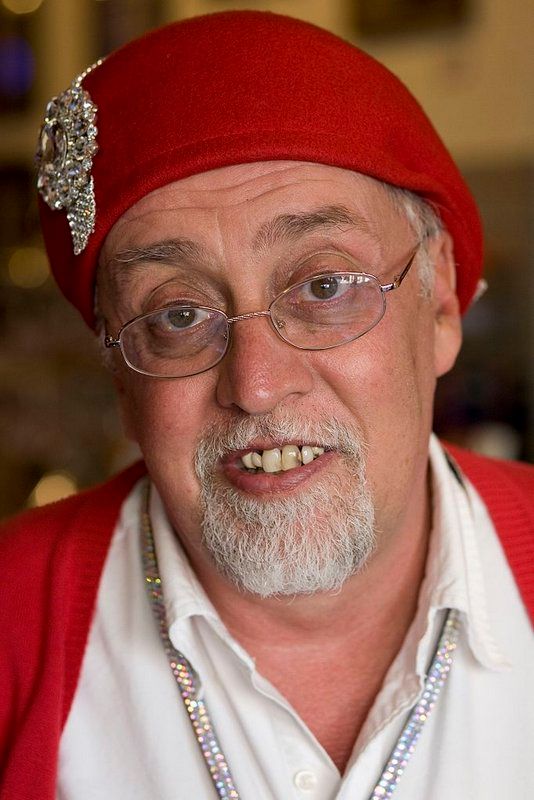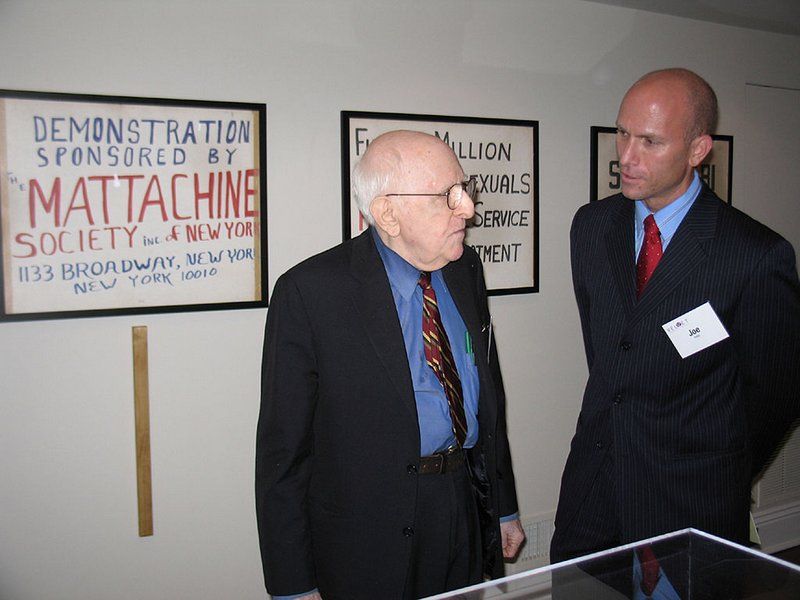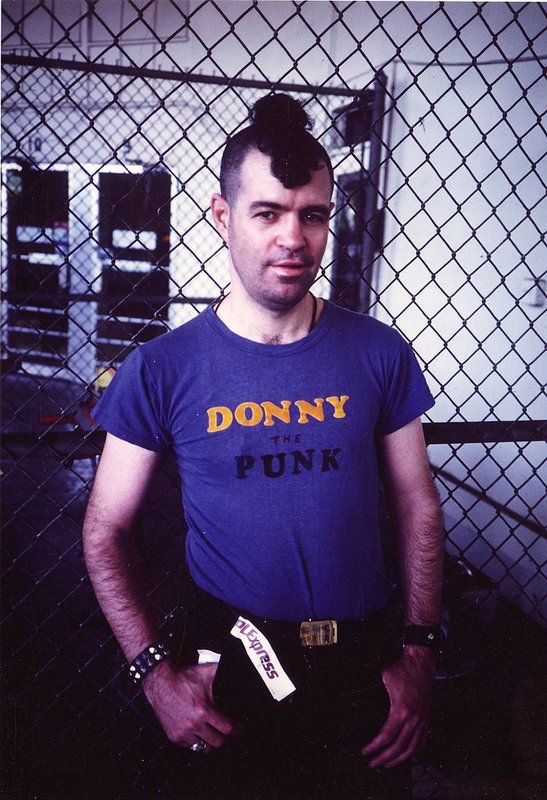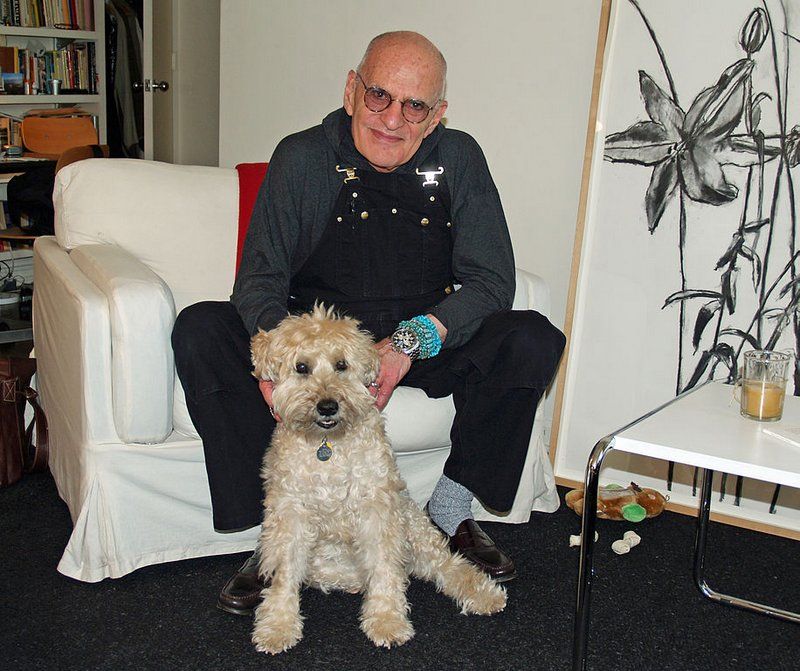Last Chance to Catch NYC's Holiday Notalgia Train
We met the voices of the NYC subway on our nostalgia ride this weekend!

Often considered to be at the forefront of the LGBTQ Rights Movement, New York City is home to many influential people and riots that paved the way for the rights the community has today. Most notably, it was the location of the Stonewall Riots, a pivotal series of violent riots in 1969.
During Pride Month, and every month, it’s important to honor the people that fought so hard for equality by challenging their peers, protesting, creating some of the first LGBTQ organizations, and providing people in the community with deep culture and history. A list of all the important LGBTQ figures who made an impact would be endless, but here are just of the 10 influential figures in New York City’s LGBTQ Rights Movement.
Barbara Gittings, often noted as the “Mother of the LGBT Civil Rights Movement,” was born in Austria in 1932. Her father was a U.S. Diplomat, but the family went back to the United States during the beginning of World War II. In school, Gittings dealt with harassment based on her sexual orientation before she even figured it out herself. She was rejected from opportunities because of her “deviant character” and lost friends when rumors of her being a lesbian spread around college. Gittings was a devout Catholic and tried to get “cured” through psychiatry as she couldn’t afford and priests. When she began exploring her sexuality and had come to accept it, she struggled to fit in with the two categories that most lesbians fell into at the time: butch and femme, and she often wore men’s clothing to try to fit in.
Despite living in Philadelphia, Gittings began the New York City chapter of the Daughter’s of Bilitis, the first Lesbian rights organization, which was created in 1955 by Phyllis Lion and Del Martin who simply wanted a space where they could dance together; at the time, this was illegal. Barbara Gittings took part in some of the first gay rights protests in New York City, kicking off the series of LGBTQ protests that would follow years later.
Gittings became the editor of the Daughter’s of Bilitis magazine, The Ladder, from 1963 to 1966. She believed that it was a way she could shape minds and make a difference in the Lesbian Community. Her activism didn’t stop there, she became involved with other organizations like the East Coast Homophile Organizations and the Homophile Action League, and the Task Force on Gay Liberation. Along with Richard Isay, she strove to remove homosexuality from the list of mental disorders to prevent the widespread issue of conversion therapy.
Barbara Gittings’ impact on the LGBTQ Community, whom she referred to as “my people,” is extensive as she was featured in a CBS documentary, Gay Pioneers. Philadelphia also created a block called “Barbara Gettings Way,” and The Free Library of Philadelphia created the Gittings Collection of LGBTQ materials in 2001.
Marsha P. Johnson, a trans woman of color born in 1944 in Elizabeth, New Jersey, is considered the main figure behind the Stonewall Riots. She was a vibrant woman who would respond with “pay it no mind,” when she was asked what the initial P would stand for.
Marsha moved to New York City in 1967 t0 get away from the persecution she faced in New Jersey, and celebrated her twenty-fifth birthday that night at the Stonewall Inn, the only place where the LGBTQ could dance and be with each other. Johnson is often cited as being the first to resist and fight back against police when Stonewall Inn was raided. People who knew Marsha claimed that she occasionally went by her name, Malcolm, and used that persona to let out her more aggressive side, but those reports are unproven. When the movie, Stonewall, released its trailer, the LGBTQ community and allies were livid that the film largely whitewashed the movement. The main character was a gay white man instead of focusing on Marsha and the other LGBTQ people of color that were at the forefront of the Stonewall Riots.
Before Marsha came out as transgender (which wasn’t yet used as the label at the time), she was a prominent drag queen as she was drawn by Andy Warhol. RuPaul, of the popular drag TV show, credits her as the true drag mother who “paved the way for drag queens.” After the Stonewall Riots, Marsha continued her activism and she and trans friend Sylvia Rivera co-created the Street Transvestite Action Revolutionaries, more commonly known as STAR, which helped support young trans women, drag queens, and street kids. Johnson also became involved in Act Up, an organization to help better the lives of people with AIDS.
Marsha was found dead in the Hudson River in 1992 and despite witnesses who saw her being harassed that day, her death was ruled a suicide.
Like Marsha P. Johnson, Sylvia Rivera was a trans woman who was at the forefront of the Stonewall Riots. Born in New York City in 1951, the Latin activist spent most of her time in the city. She had a rough beginning as she was abandoned by her father when she was a baby; her mother died when she was just three, and the grandmother who became her guardian kicked her to the streets when she was eleven, which resulted in Sylvia becoming a child prostitute. Unfortunately, trans prostitution is still common today: when parents kick their children out of the house for being different, many young trans people, especially trans people of color, have nowhere else to turn to feed themselves.
During the first Stonewall Riots, Rivera was a seventeen-year-old drag queen, and was a part of the rioting crowd outside of the Stonewall Inn in West Village. Young and unafraid, she was one of the first people credited with throwing a bottle at the police. The Stonewall Riots ignited the activism in Sylvia and she went on to join the Gay Activists Alliance, working for the cause of passing the New York City Gay Rights Bill. In all of her sassy glory, she made her way up the walls of City Hall in high heels and a dress, and crashed a meeting on the bill that she clearly wasn’t invited to.
Sylvia Rivera knew what it was like to struggle as a trans woman and became a pioneer of trans rights and the safety of others like her. She founded STAR with Marsha P. Johnson to help other trans women so they didn’t end up in a similar place as she did when she was eleven. Though she died at the age of 50 in New York City, her legacy and activism is carried on through the Sylvia Rivera Law Project, created in her name.
Born in Chicago in 1940, Craig Rodwell knew he was gay from a young age. After hearing about the gay rights group, the Mattachine Society, he moved to New York City in 1958 to pursue involvement in the group. As a prominent figure in early gay and lesbian demonstrations, Rodwell’s main focus was on activism, which left him little time to support himself; he took odd jobs here and there to survive. By organizing the “sip-in,” — modeled after the lunch sit-ins of the Civil Rights Movement at places that segregated black customers — he was able to aid in the movement to overturn the court case that allowed bars to refuse service to gay people.
Rodwell’s biggest accomplishment was the creation of the Oscar Wilde Memorial Bookshop, the first gay and lesbian bookstore. He launched the endeavor in 1967, and named it after author Oscar Wilde, who was known for having a slew of gay lovers in addition to referencing gay subjects in his writing. The original bookstore was opened on Mercer Street where it stayed until 1973, when Craig moved the store to Christopher Street and renamed it the Oscar Wilde Bookshop. In addition to holding books, the store also served as a space for meetings and offices for the gay community.
He originally pitched the idea as a Mattachine Society endeavor, but his idea was shot down. Not one to give up easily, Rodwell opened the store on his own. Also on Christopher Street, Rodwell offered up the store and his apartment to hold planning meetings for the first Pride March in the city, which was originally called “The Christopher Street Liberation Day March.” The twenty-fourth anniversary of his death is coming up on June 18th.
Ruth Simpson was born in Cleland, Ohio in 1926 and moved to New York City in 1970. Shortly after moving to the city, Ruth came out as a lesbian and took on the position of President in the New York City chapter of the lesbian organization, the Daughters of Bilitis, where she met her partner, Ellen Povill. She and Povill moved to Woodstock, New York, where they became activists in their new neighborhood.
Simpson often documented events by taking videos of them and these videos were often aired on local programming. She was featured regularly on public cable talk shows and produced the talk show, “Minority Report.” Ruth Simpson was known in the community as someone who fought for LGBT spaces, education and social networks, and she created the first Lesbian Community Center in the area. She also wrote the popular book, From the Closet to the Courts, which sheds light on the connectedness of 70’s Gay Rights Movement, feminism, lesbianism, and the Civil Rights Movement. Ruth died in 2008 from old age and breathing problems.

Gilbert Baker at SF Pride 2012 via Wikimedia Commons via Gwcreative
In March 2017 — just a few months before 2017 Pride month — the LGBTQ community lost Gilbert Baker, a prominent activist and the creator of the Pride Flag. Baker had roots in San Francisco and New York City. In 1978, Baker, with help from other prominent activists such as Harvey Milk, used trash cans at the Gay Community Center in San Francisco to create and dye the first rainbow Pride Flags for use at the parade that year. The Pride crowd responded positively to the flag immediately: without explanation, the community recognized it as its symbol.
While the Pride Flag is pretty to look at, each color has its own meaning that is representative of the LGBTQ Community: the pink stripe represented sex, the red is life, orange for healing, yellow is the sun, green represents nature, turquoise represented magic, and the purple represents the resilient spirit of the community. The flag has since changed from its original design; the pink was removed due to the cost of the fabric and turquoise and blue were combined together to create a rich blue. A controversial proposition, unveiled at the kickoff for Pride month in Philadelphia, suggested that black and brown be added to the flag as a symbol of support for LGBTQ people of color, who often face more harassment and death than white people on the spectrum. Gilbert, also known as “Busty Ross,” died in New York City.

Frank Kameny and Joe Kapp in June 2009 via Wikimedia Commons via DCVirago
Frank Kameny, often referred to as the father of the LGBTQ Rights Movement, was born in New York City in 1925. Kameny, who began fighting for gay rights over a decade before the Stonewall Riots, focused on a nonviolent approach to protesting and fighting for rights as he was strongly influenced by Civil Rights leaders, Dr. Martin Luther King Jr. and Bayard Rustin.
In 1957, after serving years in the army, Frank Kemeny was fired as an astronomer from the U.S. Army’s Map Service because he was gay. He contested his firing, which ultimately failed, but it was the first ever court petition brought forward on the grounds of discrimination of sexual orientation. This sparked Kameny’s 50-year battle against government discrimination and the firing of LGBTQ people. In 2009, he finally received an apology from the government for firing him and the Don’t Ask Don’t Tell Repeal Act was passed one year later.
Kameny was at the forefront of a lot of firsts for the Gay Rights Movement, which has since been elaborated to the LGBTQ Rights Movement to encompass all people on the spectrum. Frank Kameny started the first Gay Civil Liberties Organization in 1961 called the Mattachine Society, in addition to other organizations that later became the Human Rights Campaign and the National LGBTQ Task Force. He also organized the Annual Reminders, the first gay rights demonstrations, which promoted the phrase, “Gay is Good” (motivated by Stokely Carmichael’s “Black is Beautiful.”)
Kameny’s legacy is still celebrated in the LGBTQ community, and he was featured on the CBS documentary, “Gay Pioneers.” The Library of Congress is home to thousands of letters from Kameny’s archives and his handmade protest signs can be viewed at The National Museum of American History in the Smithsonian. Kameny died in 2011 shortly after he was honored at the repeal of the Don’t Ask Don’t Tell Repeal Act, thus living to see all of his work come to fruition.

Stephen Donaldson at the Oakland, California airport in July of 1984 via Wikimedia Commons Via Espertus
Stephen Donaldson was born in 1946 in Norfolk, Virginia with the name Robert A. Martin Jr. Back in the 60s, it was dangerous to reveal a real name in gay bars, especially when you operated a secret gay club at a prominent college like Columbia University. Thus, Stephen Donaldson, the activist, was born. As gay groups on college campuses were either nonexistent or forced to remain a secret, Donaldson would be happy to know that his efforts have paid off. Columbia, which would send gay students to psychologists or kick them out of school during the 60s, now has over a dozen LGBTQ groups, and most colleges across the country have at least one.
Donaldson faced a lot of persecution for being gay, including roommates who refused to room with him. Because he was bisexual, friends of his said that he could pass for straight and play the part easier — but sexual orientation is not always easy to hide, especially when you’re active in the movement. The group he started, Columbia’s Student Homophile League, scandalized many but retained the backing of Columbia’s chaplain, Reverend John Cannon, whom Donaldson referred to as the club’s “lightning rod.” The group was officially approved in 1967 and Donaldson went on to promote it to all of the radio stations and newspapers he could. It was the beginning of college level LGBTQ revolution as other major schools followed suit and over 150 groups popped up across college campuses within the following four years.
Donaldson reached his breaking point when he was turned away after seeking help for STDs. He came back a few hours later and held the physician at gunpoint as he demanded the penicillin injection they refused him. He was convicted on six felonies, which included exaggerated and outrages charges of kidnapping and attempted murder. He served four years of his ten-year sentence.
After facing horrors in prison, and attributing his AIDS contraction to his time in prison, Stephen Donaldson became an anti-prison rape advocate, volunteered to counsel male prison rape victims, served as the president of the Stop Prisoner Rape and was also involved with the organization, People Organized to Stop the Rape of Imprisoned Persons. In 1980, Stephen became the assistant editor of the Encyclopedia of Homosexuality and co-editor of the Concise Encyclopedia of Homosexuality. Donaldson lost his battle with AIDS in 1996, but his efforts to stop prison rape and his activism to create college LGBTQ groups are still benefiting people today. To honor his memory, Columbia University created the Donaldson Lounge.

Larry Kramer from April 2007 via Wikimedia Commons via David Shankbone
Larry Kramer was born in Connecticut in 1935, but he moved to New York, where his Gay Rights activism, plays, and work combatting AIDS strongly impacted the city. As a playwright and author, his controversial plays and novels such as Faggots, which is a satirical parody on the promiscuous nature of “Urban Gays,” often faced harsh criticism — and that particular novel was even removed from the shelves of the only gay bookstore in New York City at the time.
Larry Kramer really began to make a name for himself on the activist front in the 1980s during the AIDS epidemic. He was frustrated with the lack of response it was getting from both political figures and the gay community. Kramer often openly criticized the people who were doing nothing about the epidemic that was killing many of his friends and his community. To combat the apathy, he wrote the play, The Normal Heat, which was performed in New York City’s, The Public Theater.
Kramer didn’t stop at raising awareness of AIDS through his writing and political criticism: he also started the organization, the Gay Man’s Health Crisis, which provided information, services, and help to New York residents who were HIV-positive. Larry Kramer wasn’t satisfied with only offering services; he wanted to raise awareness in a bigger way so he started Act Up (the AIDS Coalition to Unleash Power), which strove to be loud and to “act up” by offering to pay for fines and arrests related to the cause in order to force people to acknowledge the epidemic. Kramer was successful in his endeavor as President Reagan finally addressed AIDS by name in 1987 and it was taken more seriously by politicians and the public.
Dr. Richard Isay was born in 1934 in Pittsburgh, Pennsylvania with a long list of credentials including psychiatry, psychoanalysis, gay activism, and writing. Homosexuality was considered a mental illness and had a spot in the DSM-II (the list of mental disorders in the United States) until 1987; it was removed from the American Psychiatric Association list of disorders in 1973. During the 50’s and 60’s, the abusive practice of Aversion Therapy, to “cure” homosexuality, was common and can still be found today. Dr. Isay was intent on removing the label of mental illness from being gay.
Among his accomplishments, Isay was a professor of psychiatry at Weill Cornell Medical College and also worked in the Center for Psychoanalytic Training and Research at Columbia University. Despite being born in Pittsburg, Isay spent his professional career in New York City, where he successfully changed how homosexuality was viewed from a psychological standpoint. Isay faced many hurdles both personally and professionally as he didn’t come out until he was forty and faced a lot of opposition from his colleagues. Isay sought “help” for his own sexuality, seeking out conversion therapy for ten years and after it failed to work, he changed his stance on the subject.
Dr. Richard Isay wrote three books, all centered around homosexuality, titled, Being Homosexual, Becoming Gay, and Commitment and Healing: Gay Men and the Need for Romantic Love. Despite the headway Isay made in officially removing the classification of homosexuality as a mental illness, it’s still regarded as such by some homophobic professionals and people. Richard Isay died from cancer in 2012 and was buried in Brooklyn.
Next, check out Gay Pride in NYC Through the Lens of Fred W. McDarrah and 10 Notable LGBT Landmarks and sites in NYC. Get in touch with the author @LitByLiterature,
Subscribe to our newsletter